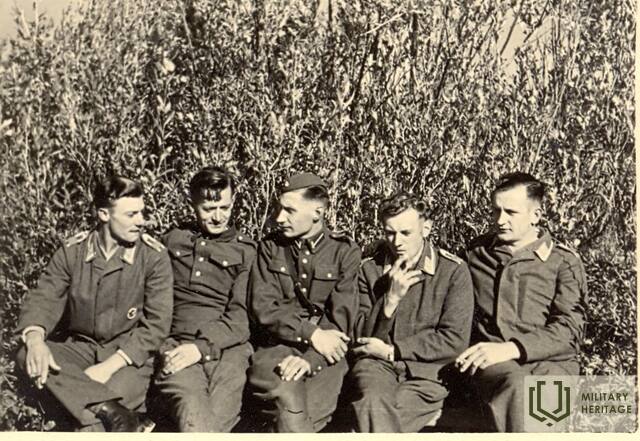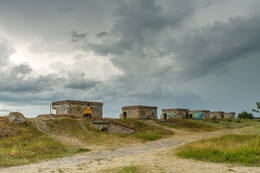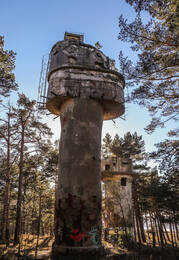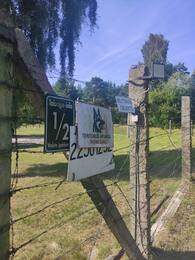Karosta – Vācijas He-111 nolaišanās vieta 1939. gadā Liepājas pludmalē
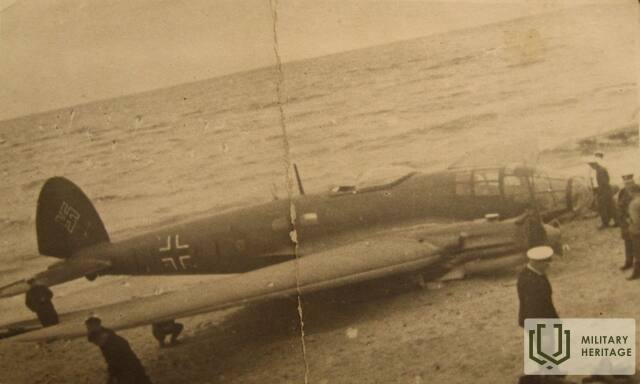
Otrā pasaules kara notikumi atbalsojās arī Latvijā. 1939. gada 11. septembrī vācu bumbvedējs Henkel He-111 veicot uzlidojumu Polijas pilsētām, naktī nomaldījās no kursa un veica avārijas nosēžanos Liepājas pludmalē. Par šo notiku stāsta Vilis Zobens, liepājnieks, Kurzemes divīzijas sakaru rotas virsniekvietnieks savos memuāros. Lidmašīnas nolaišanās vieta dabā nav apzīmēta. Vietas aptuvenās koordinātes ir N 56.59368° E 21.01598° - pludmalē netālu no Ziemeļu fortiem.
11. septembrī agri no rīta visus iztraucēja zemu lidojošas lidmašīnas troksnis. Izejot ārā, redzējām lielu, pelēku lidmašīnu ar melniem krustiem uz spārniem. Aplidojusi vairākus lokus ap mūsu mītni, tā nosēdās pludmalē. Devāmis turp. Tā bija nolaidusies tieši jūras malā. Bija izkāpuši 3 lidotāji - divi vācu virsnieki un viens instruktors. Uz rotas komandiera jautājumu, kas noticis, tie atbildēja, ka bijuši uzlidojumā Polijai, bet kompasa bojāšanās dēļ apmaldījušies un nevarējuši atgriezties savā bāzē. Aizvedām viņus uz mītni un ierādījām telpas vienā istabā. Tiem vīriem karš nu bija galā, jo pēc likuma tie bija jāintemē. Ēdienu viņi saņēma no virsnieku kluba, ar ko nebija apmierināti un vēlējās runāt ar Liepājā esošo vācu konsulu. Konsuls ieradās rotā nākamajā dienā un izkārtoja ēdienu lietu šādi: konsuls maksāja par pusdienām, ko pasūtīja Liepājas viesnīcā. To atveda rotas kareivis. Parunājos ar vācu instruktoru - motoristu. Tas bija stipri uzpūtīgs un Hitlera dievinātājs. Arī rotas komandierim ar tiem bija visādas nepatikšanas. Bijām visi priecīgi, kad tos 1. oktobrī pārsūtīja uz Rīgu.
Vilis Zobens, liepājnieks, Kurzemes divīzijas sakaru rotas virsniekvietnieks, savu dienestu Latvijas armijā sāka 1925. gadā 1. Liepājas kājnieku pulkā. Dienesta laikā piedzīvoja kā Latvijā ienāca padomju karaspēks.
Zobens, V. Memuāri, Liepājas Vārds (Latvijas Tautas fronte). 1992.
Saistītās laikalīnijas
Saistītie objekti
Liepājas cietokšņa Ziemeļu Forts un Baterija Nr.1, Karosta
Ziemeļu forti ir zināmākā un vizuāli iespaidīgākā Liepājas cietokšņa daļa. To vēsturiskais nosaukums ir Cietokšņa baterija Nr. 1 un tos uzbūvēja Krievijas cara armija 19. gadsimta beigās, lai pasargātu Liepājas jūras kara bāzi ienaidnieka uzbrukuma gadījumā, tika izbūvēti nocietinājumi tagadējās Karostas teritorijā un arī Liepājas centrā un pie dienvidu robežas.
Liepājas cietokšņa aizsardzībai no ziemeļiem starp Tosmares ezeru un jūru izbūvēja dzelzbetona nocietinājumu – Ziemeļu fortu, kuru plānoja apbruņot ar sešu 9 collu (229 mm) 1867. gada modeļa lielgabalu bateriju un lielu skaitu prettrieciena mazkalibra lielgabaliem. Līdz cietokšņa likvidēšanai izbūvēja tikai lielgabalu postamentus un munīcijas novietnes, bet pašus lielgabalus neizvietoja.
Cietokšņa ziemeļu daļā atradās viena no četrām izbūvētajām krasta aizsardzības baterijām – Baterija Nr. 1. Baterijā plānoja izvietot sešus 6 collu (152 mm) Kanē sistēmas 1892. gada modeļa lielgabalus, sešus 11 collu (280 mm) 1887. gada modeļa lielgabalus un divus 57 mm Nordenfelda sistēmas prettrieciena lielgabalus. Tikai Kanē sistēmas lielgabaliem bija pietiekami liels šaušanas attālums, lai pretotos iespējamai Vācijas Kara flotes apšaudei. Līdz ar to uz cietokšņa likvidēšanas brīdi, bruņojums bija uzstādīts tikai daļēji.
Ziemeļu forti tāpat kā Karosta padomju laikā bija slēgta militāra teritorija, taču šodien daļēji saspridzinātos vēstures labirintus ir iespējams brīvi apskatīt. Tomēr, apmeklējot Ziemeļu fortus, jābūt ļoti uzmanīgiem. Baltijas jūras stāvkrasts Karostā, tāpat kā citviet Latvijas piekrastē, ir bīstams, un krasts var iebrukt. Tāpēc nav ieteicams staigāt zem fortu drupām.
Karosta (Maršruts)
Karosta ir lielākā vēsturiskā militārā teritorija Baltijā un aizņem gandrīz vienu trešdaļu no visas Liepājas teritorijas. Karosta ir unikāls militāro un fortifikācijas būvju komplekss Baltijas jūras krastā, kas ir īpašs Latvijas un pasaules vēsturē un arhitektūrā.
Mūsdienu Karostā savdabīgi savijas grezna 19. gs. beigu arhitektūra un militārais skarbums. Ēkās saskatāms Krievijas impērijas un PSRS militāro objektu būvniecības stilu kontrasts. Karosta mūsdienās ir īpaši iecienīts tūrisma objekts.
Uzbūvēta pirms 1.Pasaules kara Krievijas armijas vajadzībām. 1890. gadā pēc Krievijas cara Aleksandra III pavēles uz ziemeļiem no Liepājas sākās apjomīga cietokšņa un kara pilsētas celtniecība. Sākotnēji tā tika dēvēta par Imperatora Aleksandra III ostu. Projektēta kā pilnīgi autonoma apdzīvota vieta ar savu infrastruktūru, elektrisko spēkstaciju un ūdensapgādi, baznīcu un skolām.
Jaunās ostas būvniecību oficiāli atklāja Krievijas imperators Aleksandrs III 1893. gada 12. augustā. Lai gan Aleksandra III nāve 1894. gadā mainīja Krievijas ārpolitiku, jaunās ostas pamatbūvniecību noslēdza 1906. gadā. Cietoksnis sastāvēja no četrām krasta aizsardzības baterijām – Nr. 1, Nr. 2, Nr. 3 un Nr. 6, kā arī vairākām fortifikācijas būvēm sauszemes pusē – Ziemeļu forts, Redāns, Vidus forts, Dienvidu forts un liela skaita munīcijas noliktavām. Pirmie karakuģi jaunajā ostā sāka bāzēties 1898. gadā.
Ostas un cietokšņa daļēju iznīcināšanu veica sākoties Pirmajam pasaules karam, pēc Vācijas Kara flotes apšaudes 1914. gada 2. augustā. Imperatora Aleksandra III ostas vēsture, kas sastāvēja tikai no būvēšanas un likvidācijas, noslēdzās 1915. gada maijā, kad Vācijas karaspēka ieņēma Liepāju.
Padomju laikā Karosta bija slēgta teritorija, kas nebija pieejama pat Liepājas civiliedzīvotājiem. Pēdējie padomju armijas karavīri Liepāju atstāja tikai 1994. gadā.
Karostā ir apskatāmi tādi militārā mantojuma objekti kā Ziemeļu mols un forti, Redans, Karostas cietums, Karostas ūdenstornis, Sv.Nikolaja pareizticīgo Jūras katedrāle, O.Kalpaka tilts uc.
Liepājas krasta artilērijas baterija Nr.2
Liepājas Karostas daudzu objektu vidū Liepājas krasta artilērijas baterija Nr.2 ir joprojām noslēpumainākā vieta Liepājā. Baterijā Nr. 2 nemainīgi bija ierīkota dažādu pastāvošo varu karaspēka munīcijas noliktavas.
Liepājas cietokšņa bateriju Nr. 2 izbūvēja tālāk no krasta līnijas un to aizsargāja augsts nocietinājumu valnis. Baterijas bruņojumā paredzēja 16 11 collu (280 mm) 1877. gada modeļa mortīras. Pēc cietokšņa likvidēšanas šeit bija ierīkotas munīcijas noliktavas. Sprādzienbīstamības dēļ teritorija 130 gadus bijusi sabiedrībai slēgta, apsargāta teritorija, bet tagad šeit ierīkota ekspozīcija par 1. Kurzemes divīzijas štāba darbību 1919. - 1940. gados, kā arī foto liecības par 1.Liepājas kājnieku pulku, 2. Ventspils kājnieku pulku un Kurzemes artilērijas pulku.




